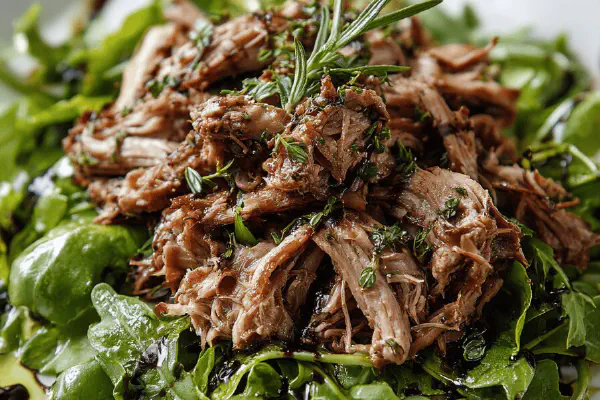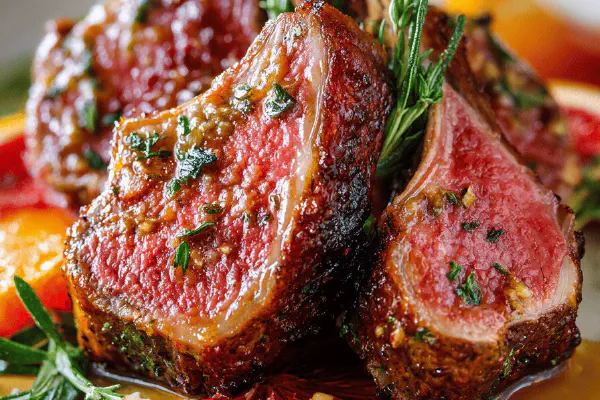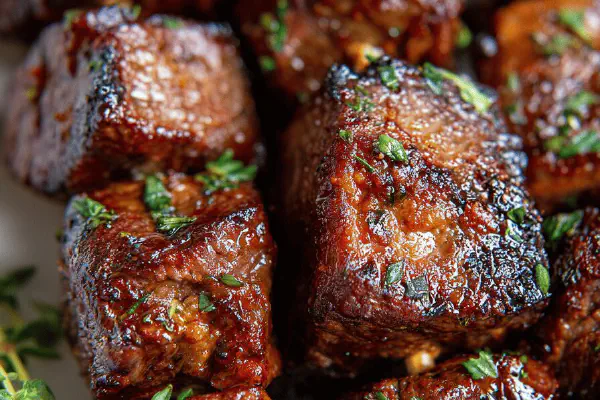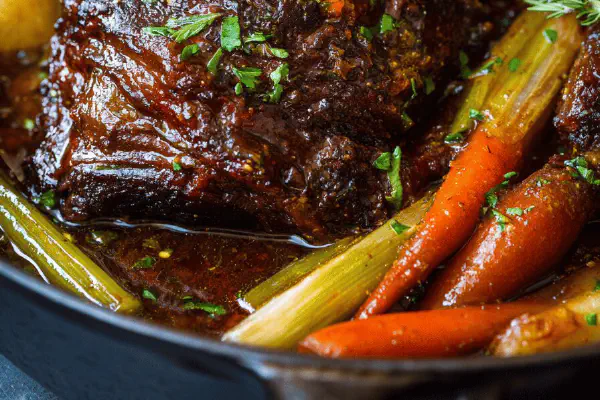Roast Leg of Lamb with Port

By Emma
Certified Culinary Professional
Ingredients
- 200 ml port wine 7 fl oz
- 90 ml cherry preserves 6 tbsp
- 25 ml olive oil 1 2/3 tbsp
- 15 ml balsamic vinegar 1 tbsp
- 10 ml whole grain mustard 2 tsp
- 1 tsp smoked paprika
- 3 cloves garlic finely minced
- 1.5 kg leg of lamb partially boned and tied with thin fat layer
About the ingredients
Method
Marinade
- Mix port, cherry preserves, olive oil, balsamic vinegar, mustard, smoked paprika, garlic in sizable glass or plastic container. Blend well; preserves must dissolve in port for even coating.
- Add leg of lamb; massage marinade to penetrate surface evenly. Seal container or heavy-duty bag flush with air. Chill 10-14 hours; overnight best to maximize flavor and tenderize meat fibers.
Cooking
- Prepare grill for indirect cooking—coals or gas flame split. Target moderate heat zone around 160-180°C. Too hot and fat burns, too low means drying. Pat lamb dry from marinade, keep marinade for basting.
- Season lamb liberally with salt and coarse black pepper. Insert rotisserie spit through center to ensure balanced turn. Wrap top of lamb with foil only if fat layer looks thin and starting to burn during initial cooking to protect moistness.
- Mount lamb on spit, place over indirect heat. Grill with rotisserie on for 75 to 90 minutes. Listen for steady rotation sound. After first hour, check color beneath foil and fat clarity. Start basting every 20 minutes with reserved marinade, adding splash of water if marinade dries too fast in pan underneath.
- Remove foil once lamb skin firms and caramelizes, about 30 minutes before end. Continue turning and basting regularly. Skins should crisp and darken but not char—watch closely.
- Test doneness with fork at thickest part; tender pulls without shredding means perfect. Internal temp target 60-65°C for medium rare to medium, depending on muscle thickness and personal preference. Carryover heat will rise a few degrees resting off heat.
- Careful with cooking times; grill irregularities and fat coverage change speeds. Smell rich lamb and cherry with balsamic hints. Juices in drip pan should thicken slightly, simmer gently to reduce if too liquidy—don’t burn.
- Rest lamb min 15 minutes loosely tented with foil to allow juices to redistribute. Slice against grain, meat fibers should part with little effort.
- Serve with reduced marinade from drip pan spooned over sliced lamb. Good with roasted baby potatoes or simple green salad. Reminds me of a summer evening when charred fat met sweet tartness—note balance always delicate.
- Common mishap: too high heat shrinks meat rapidly, dries interior despite juicy exterior. Mistake seen often with impatient cooks rushing grill setup. Patience pays, flavor intensifies with slow roasting and frequent basting.
- Don’t skip resting phase; juices locked in during cooking will flow out if sliced too soon.
- Substitutions: replace port with ruby red wine for less sweetness, or cherry preserves with blackberry jam for tartness twist. Smoked paprika replaces black pepper for mild warmth and subtle smokiness. Balsamic vinegar edges up acid, provides depth beyond mustard bite.
Cooking tips
Chef's notes
- 💡 Marinate lamb 10-14 hours chill only. Port and cherry preserves break down fibers, adds rich tang. Mince garlic fine to avoid raw bites. Mustard seeds keep texture, Dijon if no whole grain. Oil coats meat, prevents drying, helps glaze stick. Partial boning eases even cooking, fat melts slowly underneath. Skip herbs if allergies. Marinade balance key - too sweet burns fast on grill. Adjust sugar levels if needed.
- 💡 Heat control crucial. Set grill indirect zone 160-180°C max. Too hot burns fat early, dries meat inside. Rotate lamb evenly on spit; uneven turning = dry one side. Baste every 20 minutes with marinade, add splash water if drying. Foil cover top only if fat threatens to burn too soon. Remove foil for crispy skin about 30 minutes before finish. Watch color shifts - bronze edges, crisp skin, no char. Smell smoke and balsamic hint for cues.
- 💡 Test doneness using fork or probe, not time alone. Tender pull without shredding = medium rare to medium. Internal temp goal 60-65°C depending on thickness. Carryover heat raises temp off grill. Rest lamb loosely tented 15 minutes minimum. Juices redistribute, slice against grain for fibers to part easily. Slicing too early spills flavorful juices, dries meat. Pan juices reduce slowly to glaze; don’t burn, stir constantly.
- 💡 Substitutions work fine — ruby red wine swaps port, blackberry jam replaces cherry preserves. Smoked paprika can replace black pepper if mild warmth preferred. Balsamic vinegar sharpens acid; could use sherry or red wine vinegar but may shift flavor balance. Mustard seeds add crunch and rustic texture; smooth Dijon fine but less bite. If partial boning not an option, monitor fat rendering closely; thick fat needs slow melt to avoid chewy layers.
- 💡 Common mistakes: too high grill temp shrinks meat fast, dries inside despite crust. Impatient cooks rush setup, forcing faster cook = uneven results. Use drip pan for marinade catch, add water if sugars boil off too quick. Final uncovered phase critical for crisp skin. Don’t skip resting, juices will run out otherwise. Listen for steady rotisserie sound — rattles or stops signal uneven balance or slipping meat. Better slow and steady, watch closely not timer.
Common questions
How long to marinate lamb?
Minimum 10 hours cold. Overnight better. Too short means less flavor soak-in. Sugar in cherry needs time dissolve. Garlic and mustard distribute over time. Skip if rushed but lose depth.
Can I use regular mustard?
Whole grain adds texture, some crunch. Dijon smoother, less rustic. Both work but alter mouthfeel slightly. If allergic, omit, increase smoked paprika for warmth. Texture loss noticeable but no big drama.
What if grill too hot?
Fat burns, smoke overwhelms. Meat dries inside even if crust looks good. Reduce heat, use foil early to protect fat layer from flare-ups. Add water to drip pan cool sugars. Better slow cook than char fast.
How to store leftovers?
Wrap tight in foil or container. Refrigerate up to 3 days max. Reheat slow in oven, covered to keep moisture. Freeze sliced in airtight bags, thaw overnight fridge. Juices separate on cooling—recombine before warming.



